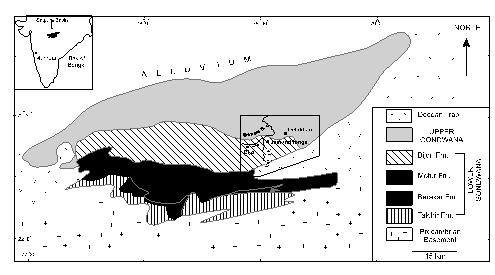Bijori Fm
Type Locality and Naming
Satpura Basin: Named by Medlicott (1873) after the village Bijori Madhya Pradesh for a unit comprising sandstone, micaceous flags and shale. [Original Publication: Medlicott, H.B., 1873. Notes on the Satpura coal basin. Mem. Geol. Surv. Ind., 10 (1), 1-188]
[Figure 1: Map of the Satpura Gondwana basin showing the extent of the Bijori Formation (Chakraborty & Sarkar, 2005)]
Lithology and Thickness
Sandstone and coal. The Bijori succession comprises of fine- to very coarse-grained sandstone, carbonaceous shale and thin coal beds. Lithology is variable from east to west, with an increase in sandy beds that finally culminate into massive sandstone near western margin (Pascoe, 1959; Sastry et al., 1977, Chakraborty and Sarkar, 2005). Presence of carbonaceous shales and coal streaks establishes its homotaxis with the Raniganj Formation of Damodar basin. Southwest of Pachmarhi it is about 180-250 m (Pascoe, 1959) but thickness is variable to 450-2000 m (Tewari, 1995).
Relationships and Distribution
Lower contact
The Bijori Formation conformably overlies the Motur Fm with a gradational transition.
Upper contact
Regional extent
Satpura Basin: The Bijori outcrop extends for a length of about 100 km between the Motur Fm to the south and the Pachmarhi Fm Sandstone to the north.
GeoJSON
Fossils
An amphibian: Gondwanasaurus bijoriensis (Lydekker 1885; Warren and Marsicano 2000) is the only report from here among vertebrates. The floristic assemblage comprises of megaflora: Glossopteris damudica, G. indica, G. angustifolia, G. retifera, G. conspicua, Schizoneura gondwanensis, Trizygia speciosa, Neomariopteris, Dichotomopteris and Dizeugotheca (Crookshank, 1936). The assemblage is comparable to the Glossopteris conspicua-G.retifera Zone (i.e Raniganj flora) of Shah et al. (1971). Mioflora is represented by Striatopodocarpites, Densipollenites, Calluminispora, Verticipollenites, Hindipollenites, Naralesporites, Alisporites, Klausipollenites, Lundbladispora, Lunatispora and Inaperturiopollenites (Bharadwaj et al., 1978; Fallujah and Kindra, 1984; Sarate and Patil 1994; Kumar, 1995).
Age
Depositional setting
Tewari (1995) inferred the Bijori Formation to represent meandering stream deposits and reported that the paleo-dispersal pattern of the sandstone units is broadly towards the north. Chakraborty and Sarkar (2005) recognized five facies associations within the Bijori Formation representing fluvial channels and associated floodplains, lake shorelines, subaqueous distributary channels and associated levees, wave and storm-affected delta front, and open lacustrine/lower shoreface deposits and interpreted that the middle and upper part of the Bijori Formation represent deposition in shallow lacustrine and lake delta setting.
Additional Information
References
Bharadwaj et al. 1978 Chakraborty, T., Sarkar, S. 2005. Evidence of lacustrine sedimentation in the Upper Permian Bijori Formation, Satpura Gondwana basin: paleogeographic and tectonic implications. Jour. Earth Sys. Sci. Educ., 114 (3), 303-323. Crookshank, H. (1936) Geology of the northern slopes of the Satpuras between the Morand and the Sher Rivers. Mem. Geol. Surv. India, 66 (2), 217-218. Fallujah and Kindra, 1984 Kumar, 1995 Lydekker, R. 1885. The Reptilia & Amphibia of the Maleria & Denwa Groups. Memoirs of the Geological Survey of India. Palaeontologia Indica, Series IV. Indian Pretertiary Vertebrata 1(5), 1-38 Medlicott, H.B., 1873. Notes on the Satpura coal basin. Mem. Geol. Surv. Ind., 10 (1), 1-188 Pascoe, E. H., 1 959. (A) Manual of Geology of India and Burma, 2. 3rd Ed., Govt. India Press, Calcutta, 485 - 1219. Sarate and Patil 1994 Sastry et al., 1977 Shah, S.C., Singh, G., Sastry, M.V.A. 1971. Biostratigraphic classification of Indian Gondwana. Int. Symp. Strat. Min. Res. Cong. Syst. Annals of Geol. Dept. Aligarh Muslim University, V & VI. 306-326. Tewari, R.C. 1995. Tectono-sedimentary evolution of Bijori (Late Permian) and Pachmarhi (Early Triassic) Formations of Satpura Gondwana Basin, central India. Ind. J. Petroleum Geol. 4 (2), 75–86. Warren A. and Marsicano. C. 2000. A phylogeny of the Brachyopoidea (Temnospondyli, Stereospondyli). Journal of Vertebrate Paleontology, 20, 462-483. Werneburg, R., Schneider, J. 1996. The Permian temnospondyle amphibians of India. In: Studies on Carboniferous and Permian vertebrates (ed.) A R Milner, Spec. Pap. Palaeont. 52 105–128.
